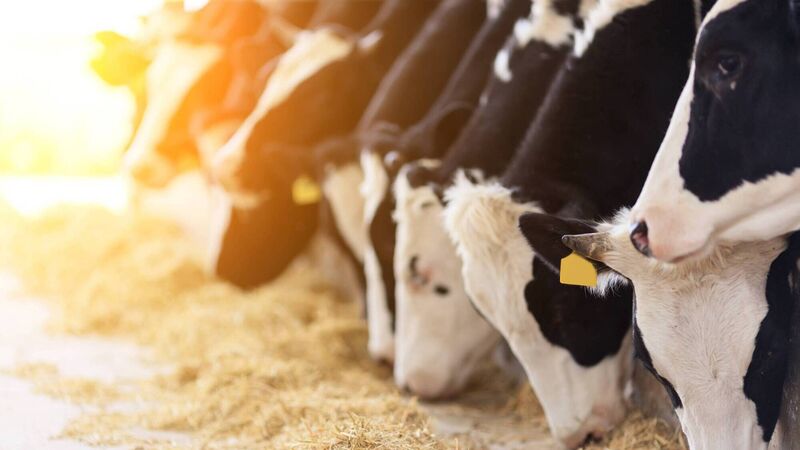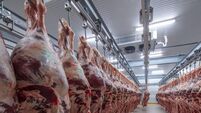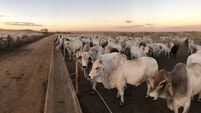Reducing stock now 'could feed whole herd for a couple weeks next spring'

Teagasc advises that farms should prepare winter fodder budgets each year to ensure adequate reserves so that farmers are not reliant on buying expensive substitutes.
Taking out a small number of your stock early "could feed the whole herd for a couple of weeks next spring", Joe Patton, head of Teagasc’s dairy knowledge transfer department has stressed.
In the coming days and weeks, don’t just look at your fodder supply on farms, but ensure you look at the demand side as well in the short term, Mr Patton advised recently.
He said that farmers should “get out and measure what you have, and then take a conservative look at what that’s going to mean for the numbers of stock that you’re projected to carry for the winter”.
Teagasc advises that farms should prepare winter fodder budgets each year to ensure adequate reserves so that farmers are not reliant on buying expensive substitutes. This summer, a total of 69,403 applications were received for the Fodder Support Scheme.
There were 7,096 applications from Co. Galway, along with 6,434 from Co. Mayo, 5,733 from Co. Cork, and 4,335 from Co. Roscommon. The online application system for the €56m scheme opened for applications on June 17, and closed on August 2.
The purpose of the scheme is to incentivise and support farmers to grow sufficient grass and conserve sufficient silage and hay ahead of this winter. This is to reduce the risk of animal welfare issues in the coming winter as a result of the Russian invasion of Ukraine in February 2022 and the impact this has had on agricultural input costs.
Payments for farmers in the scheme are expected to commence in late November, with all payments to be made before the end of the year. The payment rate is up to €100 per hectare, and the maximum area eligible for payment under the scheme is 10 hectares.
Mr Patton said that while the situation over the summer was not wholly different on farms relative to last year for fodder supply, “it has cost a lot more for farmers to get to that position” due to the cost of inputs.
Mr Patton's statement is without doubt; with regular figures from the Central Statistics Office showing that fertiliser prices increased by well over 100% in the space of a year. He said that the fodder scheme “has assisted people doing the right thing as much as being a response" to a potential shortage.
“It has been an assistance to make sure people get to the target rather than it being a response to a very clear shortage in the country.”
He said there is still a cohort of farms “that are at risk of being short – but they’re probably like that every year”.
Teagasc Fodder Survey Results were presented to the National Fodder and Food Security Committee last month and Mr Patton said that in July, “people were quite reasonably happy” with the surplus, but “what I would say is we have to be conscious also that last year there was a good reserve left over so that people are living out of last year’s reserve”.
"Things were tight" through much of the summer in a lot of parts of the country, "particularly probably the southeast and southern parts" where they were "short of rain".
“We were in a reasonably good position but it’s tightened a lot over the last month, people have had to feed a bit," Mr Patton told the .
“While we’d be saying still we’re relatively okay, it’s a little bit tighter than what it was weeks ago because we have had slow growth, and second cuts haven’t possibly materialised to the same extent people might have expected."
Mr Patton’s best advice to farmers over the last month has been “to take a look, measure what you have, measure the pits, measure the bales, don’t live in hope, do some figures”.
“It's getting late to start looking for alternatives from a silage point of view, there might be some maize or some other crop that might be available but I think for people that are showing significant shortages, they have to be looking at stock numbers, and seeing do they need to be offloading stock a little bit earlier.
“The big message is don’t just look at the supply side, look at the demand side as well in the short-term. And the sooner you do that, the less total stock numbers you’re going to have to drop. Taking out five cows now is better than taking out 20 cows in December.”
Over August, Mr Patton said that it was important that farmers tried to get some grass built up on the farm.
“The best way to avoid a long winter and have enough grass for next spring is to make sure you have a good cover of grass by the end of August, early September; so don’t take the eye off the ball on the grass covers for the next few weeks, even though things are relatively simple on farms at the moment.
“Just make sure to build enough grass because it has a big effect on the length of the winter and what you’ll have on the farm for next spring.”
There have been calls this week for the closing date for the cutting and conservation of silage and/or hay under the Fodder Support Scheme to be extended.
The closing date is September 5, but given the recent dry weather, Macra na Feirme national president John Keane has said that many farmers have had to graze paddocks and fields previously intended for silage or hay.
"Flexibility is needed around this, many farmers on all soil types across the country have soil moisture deficits on-farm and have found it difficult to secure enough winter feed ahead of the closing date," Mr Keane said.
“An extension is needed until the last week of September to allow farmers who have applied for the scheme to cut and conserve winter feed.
"Growth rates across the country have been below average for a number of weeks now and it makes sense to extend the closing date to help farmers dealing with the increasing costs of conserving winter feed."
Mr McConalogue said late last month that the Department of Agriculture, Food and the Marine continues to monitor the evolving situation of Russia's invasion of Ukraine and engages with the EU Commission, across Government, and with the industry.
"The financial supports previously announced will assist farmers in meeting the rising costs of fertiliser and in providing sufficient fodder for winter 2022," Mr McConalogue said.
"I am committed to supporting our farm families and their businesses through this very challenging period."











